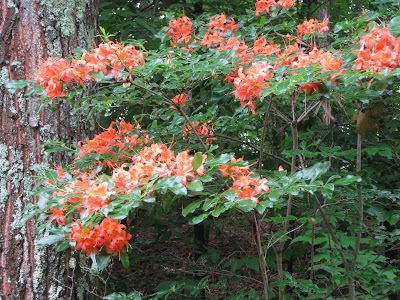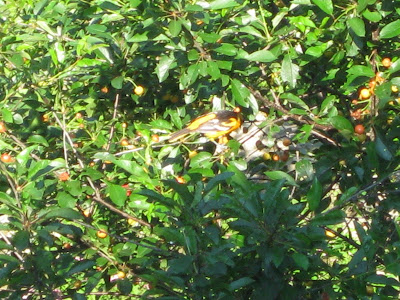This orange one is Flame Azalea - I think - it wasn't labeled and I didn't have my book.
As you can imagine, I'm even less a fan of Rhododendrons. I think they are ugly and outdated and I want to rip them out from every boring front yard I see them in. The only exception so far being these I found today next to the azaleas. Why don't we see more of these, not so overcrowded with flowers, and in intense but more "natural" colors?
Today I also revisited this great native lawn alternative. Wouldn't you wanna take a walk on this soft and beautiful sedge lawn? It looks like a plush rug for your outdoor living room. And it doesn't require irrigation, mowing, fertilization or pesticides.
If you are short of space in your garden, the keyhole design lets you put more in accessibly than the regular straight beds.
In the section about edible natives, the Three Sisters are growing again just like last year when I was there volonteering. It is a technique that have been around for thousands of years. Archeological evidence in New Hampshire's America's Stonehenge have shown that corn, beans and squash were grown together already 5.000 years ago. The beans climb up the corn stalks, and the squash cover the ground as living mulch. The beans fix nitrogen from the air and transfer it to the soil.
I did the Three Sister thing in my back yard a few years ago. The beans were fantastic and I got a few squashes, but the corn all went to the birds, which I am completely fine with.
This Swamp milkweed is so close to bursting - the buds are great looking too.
I clearly heard this frog several times give up his string-like sound, but while I was waiting with the video camera running he of course didn't make a peep.
Down by the meadow flowers are already growing tall, although it's still early for most of the flowers growing there. Later in the year this place is almost dizzying in it's plentiness of bees and buzzing and 6-7 ft tall flowers like Joe Pyeweed, Culver's root, Mountain mints, Ironweed and others.
I actually have no idea what this yellow Lupine looking flower is. Obviously the name does not matter to all the bees that frantically buzzed around it as if their last minute was near.
This is not a great picture, but it does show a Baltimore Oriole in my neighbor's cherry tree. My generous neighbor has long time ago resigned to the fact that the birds get the berries before he gets a chance. And I get to watch the show every season.
Another bee favorite is this Catalpa tree flower. Look at the colorful landing pads and intriguing dots meant to securely guide the bee all the way in to the holy nectar. Although even a blind bee wouldn't miss this tree since it also has a wonderful honey sweet fragrance lingering in my neighborhood right now.
This last picture is of the wildflower plantings outside my community garden. Tall Meadow rue - over 6 ft tall this year!















No comments:
Post a Comment